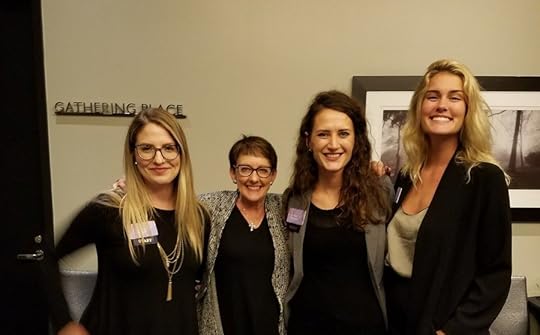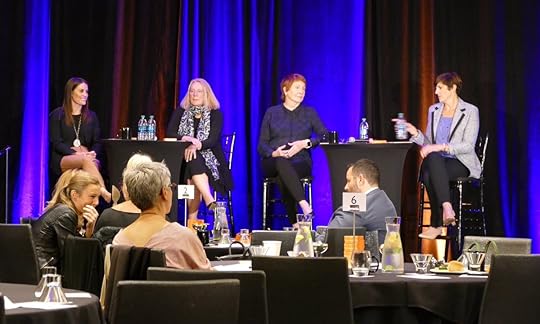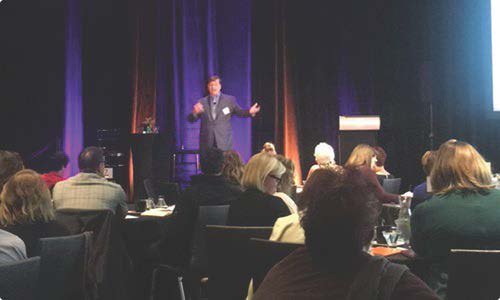Susan Scott's Blog, page 32
September 20, 2017
New Research: The State of Miscommunication: 6 Insights on Effective Workplace Communication

We’re excited to announce Quantum Workplace’s launch of the Fierce + Quantum eBook on the state of miscommunication in the workplace. The free eBook dives deep into the issues of miscommunication and offers solutions for creating more engagement and clarity in one-on-ones, team meetings, and organization-wide. We wanted to conduct this research on miscommunication to fully understand the impact it’s having on organizations, including the costs (time, money, engagement, relationships, productivity, and more), and explore how effective conversations can help.
Fierce + Quantum
Quantum helps organizations retain top talent, motivate performance, understand turnover, and build magnetic cultures. Their studies reveal that communication is indeed at the heart of employee engagement. Fierce and Quantum have both researched employee engagement in the past, and have weighed in on the conversations needed to improve engagement and workplace culture.
In preparation for this eBook, Quantum Workplace and Fierce Conversations designed a survey to capture perceptions on workplace conversations, miscommunication, and employee engagement. This study surveyed 1,344 employees and used Quantum Workplace’s e9 model, which measures engagement using a set of nine survey items that tap into work, team, and organizational engagement.
What’s in it for you?
Research from Fierce Conversations and Quantum Workplace reveals trends around miscommunication in the workplace and finds that effective workplace communication is directly linked to employee engagement. When engagement suffers, it costs you and your organization time, money, and results. The eBook content contains eye-opening data and reveals the types of conversations necessary to increase engagement, create change, and shift your workplace culture.
Sponsored by Fierce Conversations, this eBook includes:
• Research behind the benefits of high quality conversations with managers and peers
• Insight on who’s responsible for miscommunication in the workplace
• A look at challenges in communicating effectively via technology
• Tips on creating a voice-empowered culture and freeing employees to speak their minds
• Best practices for overcoming common miscommunication challenges, in both one-on-one and meeting settings
• And more!
The post New Research: The State of Miscommunication: 6 Insights on Effective Workplace Communication appeared first on Fierce, Inc..
September 18, 2017
Fierce Tip of the Week: Don’t Assume, Ask!
We write about making assumptions often on the Fierce blog, because inaccurate assumptions are the Achilles’ heel of conversations.
Asking questions, checking for understanding, and being thorough are how you can combat making wrong assumptions.
Often we skip over the chance to dig deeper and get clarity, not because we are afraid to, but because we are moving too quickly or underestimate how costly not asking is.
This week’s Fierce tip encourages you to ask, in the moment, all the questions you need to ask in order to be clear.
If you encounter impatience, speak to it, and explain that taking the time now for you to fully understand will avoid costly mistakes later. And, if you leave a conversation feeling like you do understand, yet you find yourself making assumptions, stop what you are doing and re-engage in the conversation.
The post Fierce Tip of the Week: Don’t Assume, Ask! appeared first on Fierce, Inc..
September 15, 2017
TED Talks – Ideas Worth Spreading
We’re obsessed with TED talks! Here are our recommended must-watch videos, including the TED Talk with Susan Scott, ‘The Case For Radical Transparency.’
The Case for Radical Transparency
with Susan Scott, CEO & Founder of Fierce, Inc.
How To Build A Company Where The Best Ideas Win
with Ray Dailo, Founder of Bridgewater Associates
The post TED Talks – Ideas Worth Spreading appeared first on Fierce, Inc..
Friday Resource: Up is Not the Only Way: Rethinking Career Mobility

When we think of career growth, we tend to think about “moving up” the ladder. However, in today’s workforce, much is changing. Organizational hierarchies are less commonplace, jobs are more mobile and flexible than ever, and individuals are in a position to truly own their careers.
Earlier this week, authors Beverly Kaye, Lindy Williams, and Lynn Cowart released their book titled Up is Not the Only Way: Rethinking Career Mobility. The book presents an alternative way of looking at our careers and presents tips for navigation that can advance our personal and professional growth and development in somewhat less-traditional (yet equally rewarding) ways.
This book guides its readers into thinking about career mobility in a way that can lead to more options, and show how managers, coaches, and employees can partner to determine what’s best and what’s next. To give you an inside peek, here’s a content preview from the first chapter:
Let’s Be Honest
Up was never for everyone. It still isn’t. Managing someone else is not on everyone’s radar. Neither is taking on increasing levels of responsibility (really!). Not everyone wants to move up. That doesn’t mean a rewarding career is out of reach. The message has been out there for a while now that individuals own their careers. What does that really mean? We think it means that the definition of career success is up to each one of us. Every time circumstances shuffle the deck, you can deal yourself a new hand. That’s good news…actually that’s great news! We are the only ones who can envision and imagine what success will look like. And, to add to that great news, as the creators of our career success pictures, we are free to alter them when and how we choose to! That is what it means to own a career. But, if we own it and we can create it, how do we do it? First it’s about being mobile.
Career Mobility…
…is essential for individuals at all levels. Each one of us needs to exercise agility and resilience that stable workplaces did not require. No longer is mobility just about physically moving to another building or town. It’s more than getting promoted. It’s sometimes just being willing to continue to learn and grow and stretch.
…is about flexibility and agility. Like the navigation systems we rely on to reroute our travels based on traffic patterns, career mobility means flexing, adapting, and anticipating what’s next.
…involves a rich mix of experiences, roles, assignments, and options. Careers today require us to be open to exploring multiple opportunities and possibilities. Great careers will be the payoff for employees who watch for and recognize emerging growth opportunities and are ready with alternatives when options fade or change. Second, it’s about ownershift!
Ownershift: Who Does What?
We’ve all heard that employees own their careers. The organization needs to provide tools and resources, and managers need to support employees’ career development. It’s a partnership. Nothing new there! What is new is talking less about the ownership and more about the ownershift—the need to fine-tune who owns what—and about what each player needs to do to demonstrate commitment to the partnership…
To read more, purchase the book here.
The post Friday Resource: Up is Not the Only Way: Rethinking Career Mobility appeared first on Fierce, Inc..
September 14, 2017
Fierce Summit 2017: Day 2 Highlights

Day two of the fabulous Fierce Summit has come to an end, and today’s sessions came with powerful takeaways.
Starting from earliest to latest…
Regent Cornell: How to Build a Culture
Ultimate Software’s tagline “People First” wasn’t drummed up by the marketing team to win awards or sell more widgets. It’s the way things are done at this fast-growing cloud computing company that landed it a top spot on Fortune’s 2016 List of the “100 Best Companies to Work For.” With a personal story that was both humorous and insightful, Regent Cornell revealed the five distinguishing characteristics of ‘Best Companies’ and demonstrated the bottom-line impact of putting People First: 1. Gratitude, 2. Respect, 3. Engagement, 4. Authenticity, and 5. Trust.
Learn more about how Ultimate Software made the list .

Susan Scott: Become a Great Conversationalist
In this intimate session, Fierce founder and CEO Susan Scott made the connection between conversations and leadership, and why conversations matter to your individual and collective success. Susan also shared some of her secrets with us:
The secret to success: Be true to thyself.
The secret to failure: Try to please everyone.

Conversations That Matter: A Global Perspective
Spanning across Australia, Lebanon, and Columbia, this panel consisted of three Fierce individuals who dived deeper into conversations that matter from a global perspective and discussed how they teach clients the strategy of Fierce Conversations. This was an incredibly moving session that that really highlighted the heart and the “why” of facilitation and the positive impact Fierce conversations are having in communities around the world.

Seattle Special Guest: Brain Canlis
Our special guest Sean O’Connor, writer and brand strategist, interviewed Brian Canlis, one of Seattle’s most renowned restaurateurs. Brian shared stories behind his family legacy, which was rich with tradition, and how over generations they discovered that the most important story is the story of their customer.
A quote we won’t soon forget: “Courage: it’s like skinny dipping. It’s super fun but no one wants to go first.” –Brian Canlis
I highly recommend adding Canlis to your dinner plans if you haven’t been. It’s an unforgettable culinary experience with amazing views of Seattle.

Wendy Finlason Seymour: How Randstad Shifted its Culture, One Conversation at a Time
Randstad knew that many important conversations were not occurring, and leaders needed a tool to help them communicate courageously. Starting in 2014, Randstad implemented Fierce Conversations, providing a framework for employees to engage in productive, genuine conversation, truly addressing the minds and hearts of the matter. Wendy Finlason Seymour shared the timing, tools, and strategies they’ve used to shift Randstad’s culture. She discussed the importance of conversation in transforming culture, how to implement a successful strategy and how to make it stick, and provided examples of how to drive lasting cultural change for organizations.
Learn more about Randstad here.

Fierce Generations
Building on the Birkman Assessment from day one, attendees gained more insight into unique perspectives through the lens of generations. In this interactive session, the assumptions we all hold about different generations were challenged. The truth was revealed…we are more alike than different!
Fun fact: The Fierce executive team is made up of four women from all four generations!

The Fierce executive team closed out the day with a few final words of thanks. From all of us…
Thank you, thank you, thank you!
We want to give huge thanks to everyone who took part in our unforgettable event: our guest speakers (including Juliet Funt, Dan Perryman, Lisa Reynolds, Greg Fratantoni, Trina Hamilton, Debra Music, Regent Cornell, Brian Canlis, and Wendy Finlason Seymour), our attendees, our clients, the W Hotel and staff, our coordinator Janet Hoppenstein, and our Fierce “Fiercelings” who poured their hearts into making it possible. We want you to know that you’re appreciated, on the deepest level, for all that you do!
The post Fierce Summit 2017: Day 2 Highlights appeared first on Fierce, Inc..
September 13, 2017
Fierce Summit 2017: Day 1 Highlights

The Fierce Summit has finally arrived!
This one-of-a-kind leadership and learning event has been anticipated throughout the year by both the Fierce community and those who are new to Fierce. The event is taking place in the wake of much time, commitment, and TLC on behalf of the Fierce team, our clients, attendees, and speakers.
After our special facilitator day on Tuesday the 12th, this was our first day of the official two-day event hosted at the W Hotel in downtown Seattle.
Our speakers were carefully chosen for their messages–messages that are both inspiring and on the cutting edge of leadership. These powerful messages resonated with their audience today in a way that I believe will leave a lasting impact. Here are some notable speaker highlights from day one:
Juliet Funt: Activity is Not Productivity: Raising Execution Through Reclaiming WhiteSpace
After Susan Scott’s warm and insightful introduction, Juliet Funt, founder of WhiteSpace at Work, was the first guest speaker to present. She opened her presentation with humor and a personal story about how she came about WhiteSpace through an “aha” moment she had when her son wouldn’t stop talking. She discussed how we’ve come to fear pausing in our daily lives, both in conversation and in the midst of our activities. She also touched on the “tyranny of the urgent,” which is made up of 100% exertion and 0% thoughtfulness, stating that we claim to be “too busy to become less busy.” She clarifies that work can look a lot of different ways, and WhiteSpace consists of taking a “strategic pause” to allow creativity and fresh ideas to enter our minds. When we are overloaded, she says we need to “de-crappify” our workflow. She touched on the 4 Thieves of Productivity: 1. Drive, 2. Excellence, 3. Information, 4. Activity. Juliet explained that while these are all positive attributes, overdoing them can be detrimental to ourselves and our organizations.
Read more about WhiteSpace, the thieves, and how you can combat them here.

Dan Perryman: When Social Science Gets Fierce
Next up was Dan Perryman, Birkman VP of Training. Before the first day of the Summit, our attendees were prompted to take the Birkman Method Personality Assessment so everyone could use their results to follow along with Dan’s presentation. He detailed the “Birkman map,” a color-coded chart that plots where you are on the extrovert/introvert scale (vertical) and the people/task scale (horizontal). The map also addresses where your interests, usual behaviors, needs, and stress behaviors lie in relation to these scales. Dan tied our usual behaviors, interests, and needs into Fierce Conversations by mentioning which colors excel at certain conversations—for example, reds tend to excel at confrontation, blues tend to excel at coaching, yellows tend to excel at delegation, and greens tend to excel at beach ball conversations. One thing Dan mentioned that in my mind helps differentiate the Birkman assessment from other assessments is that the results are not intended to box you in—in fact, we are all made up of some percentage of all of these colors, much like a kaleidoscope. The results encompass so much information that can help us understand ourselves, each other, and how we can make the most of our conversations at work and in life.
Find out more about the Birkman Method Personality Assessment here.

Lisa Reynolds & Greg Fratantoni: Honest, Meaningful Coaching Conversations Set the Stage for Performance Transformation
Our wonderful clients Lisa Reynolds, VP of Talent Management, and Greg Fratantoni, Director of Workforce Planning and Performance Management with CHRISTUS Health spoke about their relationship with Fierce and how they used Fierce programs to shift company culture. CHRISTUS Health was recognized by The International Coach Federation (ICF) as an organization with an effective coaching culture. How did they get there? What does it take to pivot from “nice” conversations to robust performance conversations? They spoke about embedding coaching skills into leadership development and how that capacity made the journey to transform performance management an easier task.
To learn more about their success, check out the Fierce + CHRISTUS Health case study here.

Trina Hamilton: Creating a Fierce Movement Through Leadership Development
In this session, Trina Hamilton, Head of Leadership Development and developer of the Leaders Who Inspire (LWI) program at Coast Capital Savings has integrated Fierce Conversations into LWI, creating common language and “ways of being” that enable leaders to build trust quickly, align themselves effectively, and drive to creative outcomes that resolve issues and drive organizational results. Trina provided valuable and actionable details on how you can create a framework that will enable you to leverage Fierce Conversations and build your own signature leadership program, regardless of your organization’s size, type, or industry.
Read more about our partnership with Coast Capital in our case study here.

Seattle Special Guest: Debra Music
We were excited to welcome Debra Music, CMO of Theo Chocolates, to the Fierce Summit. Seattle is a city full of booming businesses and successful organizations, and Debra is a success story who turned her dreams into reality. She shared details of how she created an organization that betters the world, one chocolate bar at a time.
Take a chocolate tour here.

Day one has come to an end. Can’t wait for more learning and insights on day two!
The post Fierce Summit 2017: Day 1 Highlights appeared first on Fierce, Inc..
September 11, 2017
Fierce Tip of the Week: Stop Your Excuses. You are the Culture.

Having a positive culture has real impact on business and your happiness at work. In fact, a Columbia University study shows that the likelihood of job turnover at an organization with rich company culture is a mere 13.9 percent, whereas the probability of job turnover in poor company cultures is 48.4 percent. That makes a huge difference…not just for the employer, but also for the fellow employees.
Although people cerebrally understand culture's importance, people tend to talk about culture as something external.
 For instance, a statement I often encounter when we are discussing fierce is: “My culture doesn’t encourage transparent, direct communication, so I can’t have those kinds of conversations with my executive team right now.” Sometimes that also sounds like, “If my company’s culture was different, I would be different.” Or “If other people modeled those behaviors, I could do them too.” What I hear is “Look at those other people over there – no, not me, not here.”
For instance, a statement I often encounter when we are discussing fierce is: “My culture doesn’t encourage transparent, direct communication, so I can’t have those kinds of conversations with my executive team right now.” Sometimes that also sounds like, “If my company’s culture was different, I would be different.” Or “If other people modeled those behaviors, I could do them too.” What I hear is “Look at those other people over there – no, not me, not here.”
Newsflash: Culture doesn’t live outside of you. That’s not how it works. You are the culture. You choose what it looks like every day. You choose it in the conversations you have. And even more so if you lead people, you model and reinforce those choices each time you interact with others.
This week’s fierce tip is to take responsibility for your impact on your organization’s culture. Ask yourself: What kind of culture do I want to be a part of? What does that require of me?
Yes, there will be issues that are legitimately outside of your control or purview. However, you have as much responsibility as everyone else to steer the culture.
So as seducing as pointing the finger can be at times, when you are unhappy with the culture, make sure you throw some of that blame your way.
The post Fierce Tip of the Week: Stop Your Excuses. You are the Culture. appeared first on Fierce, Inc..
September 8, 2017
Friday Resource: How These Top Companies are Getting Inclusion Right

This week’s Friday resource comes from Fast Company and highlights the ways top companies have achieved results through their inclusion strategies.
Inclusion produces a domino effect with more than one benefit: it creates a culture where employees feel encouraged, appreciated, and engaged, which leads to more innovation and collaboration, which then leads to positive results for the bottom line.
Creating an inclusive culture requires a proactive approach on behalf of HR and leadership. Unfortunately, many traditional diversity and inclusion programs are ineffective and fail to address factors that are key when attempting to create cultural shifts.
Per Gwen Moran, Fast Company, here are some often overlooked strategies from top companies who have successfully transformed their organization’s culture into one of inclusion and diversity:
1. Emphasize from the start.
“At Johnson & Johnson, communicating the importance of inclusion is critical. At every level of training, diversity and inclusion are emphasized. ‘As we are going through our talent process throughout the year, whether goal setting or coaching conversations or a mid-year review, we’re always giving out training materials, and we’ve embedded diversity and inclusion into those materials so that people are always thinking about how they can be more inclusive and making sure that there aren’t any hidden biases that may be impacting our thinking,’ says Wanda Hope, chief diversity officer.
Johnson & Johnson regularly communicates the organizational commitment to diversity, both internally and externally. In addition, such communication can help attract a more diverse talent pool.”
2. Make it a performance marker.
“Inclusion leaders also have other mechanisms in common: feedback mechanisms and accountability. At EY, Johnson & Johnson, and others, managers have clear diversity and inclusion goals, and fulfilling them is part of their performance review.
But it’s not just a stick without a carrot. EY’s team recognizes managers who are good at fulfilling those goals. ‘In our organization, those executives that do really well and continue to advance further and faster are those that include acumen around inclusive leadership on their client serving team. It’s also critical for advancement and success in addition to day-to-day performance,’ says Karyn Twaronite, EY partner and global diversity and inclusiveness officer.”
3. Create community.
“At AT&T, having ‘a true culture of inclusion where every voice matters’ is one of the reasons the company has been so successful in its diversity and inclusion initiatives, says Cynthia Marshall, senior vice president, human resources and chief diversity officer. Over the past decade, the company has created a dozen employee resource groups (ERGs) and employee networks (ENs). ERGs are nonprofit groups that provide support, advocacy, education, mentoring, and more to groups such as women, generations, military veterans, people with disabilities, and members of the LGBT community. ENs are more informal, typically focus on business or professional development issues, and are developed with cross-functional diversity as a priority.”
Read further into these strategies and the rest of the article here.
The post Friday Resource: How These Top Companies are Getting Inclusion Right appeared first on Fierce, Inc..
September 6, 2017
Why Your Traditional Diversity Training Program Isn’t Working

Each year, organizations invest a lot of time and millions of dollars into diversity programs.
I hate to break it to you, but the return on both the investment and expectations of traditional diversity efforts is falling terribly short.
As a baby boomer, my career followed the new path of diversity. It wasn’t about inclusion at all. It was about numbers. The intent was good. The thinking was that if you change the numbers you would change the culture. Fortunately, we have learned so much and still have so far to go.
Traditional programs are still not touching on some of the most critical issues that need to be addressed. In 2016, in a speech to the Cleveland Metropolitan Bar, diversity consultant Verna Myers said, “Diversity is being invited to the party; inclusion is being invited to dance.” Traditional programs are just an invitation to the party. They become hollow attempts at cultural change.
Here are a few things that are not addressed in traditional programs:
The current state of affairs. Over the past couple of years, the geopolitical climate has been in upheaval and the related tension has found its way into the workplace. Our Fierce survey released earlier this year on diversity and discrimination revealed some startling statistics: 18% say they have seen others discriminated against based on race, 20% on political beliefs, and 21% on gender. Perhaps the most startling of all, one in five individuals surveyed have felt unsafe at work. For women, that increased to more than a quarter of those surveyed.
These stats should serve as an alarm bell for leadership. Traditional programs do not teach leaders the conversation skills necessary to navigate the issues related to physical and psychological safety in the workplace, including those caused by current social and political events.
The illusion of inclusion. While leadership should own the decision, it’s important for leaders to seek the input of their teams and genuinely take this input into consideration before finalizing the decision. An illusory approach to inclusion doesn’t fool employees. They will know, and it will come at a big cost to an organization’s culture by decreasing trust and morale. Employees need to know their input is valued. Inclusion, when practiced effectively, is anything but an illusion.
Conversations. Many diversity programs focus on shifting the behavior and mindset of each program participant. While this mindset shift is important, it only goes so far. Conversations, and the skills needed to have them effectively, are paramount for improving company culture. Inclusion requires conversations about what isn’t working so individuals and teams can collaboratively create alternatives.
So how can organizations produce tangible return on their diversity and inclusion strategies? Here’s a start:
1. Adopt the beach ball mentality. Our Fierce team model uses the analogy of a beach ball to introduce a new way of thinking. Each colorful stripe on the beach ball represents a single perspective. To see the full picture, or “the full beach ball,” each stripe is needed. Each person within an organization owns a piece of the truth, and actively seeking input is necessary to see the full truth of an organization. When leadership adopts the beach ball mentality, the organization takes a significant step towards true inclusion.
2. Implement conversations training, and mandate it across all leadership levels. Many organizations don’t realize that ineffective conversations are the leading cause of their business problems. The solution is knowing what to talk about, how to talk about it, and why it matters to the bottom line. Effective conversations are the key to producing any result, including improvements in company culture—this is why it’s imperative to equip leadership with the skills to have them.
3. Start having the tough conversations. Ignoring issues doesn’t work. Any problems that are swept under the rug will grow until they become so big that you have no choice but to deal with them. At Fierce, we use the term “Mokita”—that which everyone knows and no one speaks of. The only way to get the results you want is to deal with the elephant in the room by tackling tough challenges and interrogating reality through conversations. Work up the courage to speak with the people who matter most to the issue.
This is just the tip of the iceberg. Our latest whitepaper, Build an Inclusive Culture: 3 Strategies to Maximize Innovation, provides an analysis of the problem and actionable solutions to transform your organization’s culture in a way that will lead to more innovation and measurable results.
There is an incredible amount of positive intention behind all diversity programs, but traditional training isn’t going to provide impact or the return you want to see in your organization. Let the unaddressed issues serve as a wake-up call, and begin taking the necessary steps to improve your current approach. You can’t afford not to.
The post Why Your Traditional Diversity Training Program Isn’t Working appeared first on Fierce, Inc..
September 4, 2017
Fierce Tip of the Week: Think Outside the Box

It’s easy to fall into a pattern. It’s only natural to apply your knowledge of a process, that you know works, to similar projects. You might think to yourself: I know an effective way to do this, why fix something that isn’t broken?
This week’s tip is to question your processes, patterns, and ideas. Challenge yourself and those around you to think outside the box.
This can be an effective exercise whether you’re in a defined, “official” leader role or not.
Sometimes when our first instinct is to just streamline an idea, it can dampen the instinct to innovate. Thinking outside the box doesn’t mean making things more complicated. It can be as simple as getting more creative with how you spend your time in weekly meetings, how your organization handles customer service interaction, and even a new way your audience can interact with the brand of your company.
If you have an out of the box idea that you’ve been sitting with for a while, take the time this week to bring it forward. If the opportunity to innovate this week comes your way, call on your experience of how things have worked in the past and challenge yourself to get more creative. Suggest an idea you might not normally suggest.
What you come up with may surprise you!
The post Fierce Tip of the Week: Think Outside the Box appeared first on Fierce, Inc..
Susan Scott's Blog
- Susan Scott's profile
- 859 followers




